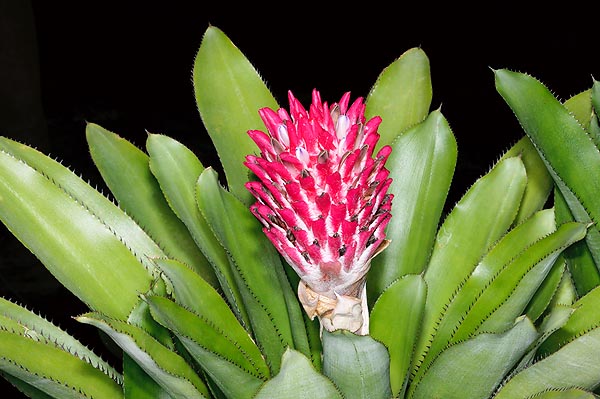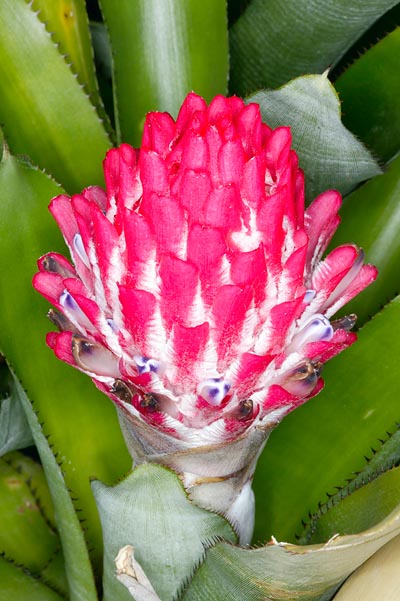Family : Bromeliaceae

Text © Pietro Puccio

English translation by Mario Beltramini

The Quesnelia arvensis is native to south-eastern Brazil © Giuseppe Mazza
The Quesnelia arvensis (Vell.) Mez (1892) is native to south-eastern Brazil, where it grows on sandy formations or on the trees of the coastal forests.
The genus is dedicated to the French consul in French Guyana, M. Quesnel, who introduced the genus in France in 1840; the name of the species comes from the Latin “arvum” = ploughed field, but also beach, with reference to its habitat.
Common names: “flamingo cone” (English).
Evergreen herbaceous plant, monocarpic (bearing fruit only one time during its existence), acaulescent, terrestrial or epiphytic, it has a funnel-shaped rosette of leaves placed in such a way to form a central cavity usually filled up with water.
The 25-70 cm long and 4-6 cm broad leaves, linear, rigid, ascending and ending with an about 10 mm thorn, are of green colour with transversal silvery grey bands on the back and dark brown thorns, 3-4 mm long, on the edges. The inflorescence, at the centre of the rosette, is formed by the robust floral scape, 20-40 cm tall, covered by imbricate, membranous bracts, 5-15 cm long and 3-6 cm broad, of a greenish or pink colour, which ends with a thick simple inflorescence, cylindrical or ellipsoidal, 5-15 cm long and with a diameter of 5-8 cm, formed by intense pink or red bracts, 30-45 mm long, with a rounded apex. From the bracts, which keep unchanged for about 8 weeks, come out, in sequence, the flowers, 45 mm long, with violet petals turning to the white.

Inflorescence of Quesnelia arvensis © Giuseppe Mazza
The fruit is a 20 mm long berry, of 10 mm of diameter, containing several fusiform seeds, 2 mm long, greyish.
It reproduces, besides by seed, by vegetative way, through the robust stolons produced at the base of the plant.
Plant suitable for being cultivated in tropical and subtropical climates with marked seasonal changes, and, in sheltered position, also in the Mediterranean type climates, as it can stand temperatures till -3/-4°C, both in full sun and in half-shade and on soils even poor, sandy, particularly draining, being subject to rottenness due to water stagnation, especially in connection with low temperatures.
In more humid climates, it can be cultivated also as epiphytic on the trees. Its best location, on the ornamental point of view, is in the “desert” gardens, even coastal, as it can stand a high salinity in the soil and in the marine aerosols, besides an intense solar irradiation and reduced availability of water.
It can be cultivated in pot for indoor decoration, both in full light and in shady position, utilizing a particularly draining and porous substratum, with temperatures over the 14-16°C.
In summer, the substratum must be kept slightly humid, and the local humidity, in presence of dry air and high temperatures, can be, if needed, increased with nebulisations utilizing water at room temperature and not calcareous for avoiding anti-aestethic dots on the leaves. In winter, watering must be spaced, thus permitting the substratum to dry up.
In summer, some water can be left in the central cavity formed by the rosette of leaves, renewing it frequently for avoiding that it becomes a nest of mosquito larvae, whilst in winter it is better to leave it dry to avoid possible rottenness.
Synonyms: Bromelia arvensis Vell. (1829); Ananas arvensis (Vell.) Steud. (1840); Quesnelia rufa var. sororocabae Lindm. (1891); Quesnelia arvensis var. sororocabae (Lindm.) Mez (1935).
→ For general notions about BROMELIACEAE please click here.
